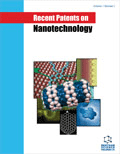
Recent Patents on Nanotechnology
Scope & Guideline
Empowering Nanotechnology Experts with Cutting-edge Insights
Introduction
Aims and Scopes
- Drug Delivery Systems:
The journal publishes research on various nanocarrier systems, including lipid nanoparticles, silver nanoparticles, and polymeric nanoparticles, emphasizing their formulation, characterization, and therapeutic applications. - Material Science and Engineering:
There is a strong focus on the synthesis and application of nanomaterials for enhancing the properties of existing materials, such as metallic nanoparticles and nanocomposites for electronics and energy storage. - Environmental Applications:
Research that explores the use of nanotechnology for environmental remediation, including water treatment and waste management, is a significant area of interest, highlighting the potential for sustainable solutions. - Patent Analysis in Nanotechnology:
The journal frequently features patent reviews and analyses, providing insights into the technological advancements and trends within the field, thereby serving as a resource for researchers and industry stakeholders. - Innovative Therapeutics:
The publication covers novel therapeutic strategies employing nanotechnology, particularly in oncology and chronic diseases, showcasing preclinical and clinical advancements.
Trending and Emerging
- Nanotechnology in Cancer Therapy:
Recent publications highlight significant advancements in the use of nanotechnology for cancer treatment, including targeted drug delivery and novel therapeutic agents, showcasing its potential to revolutionize oncology. - Green Nanotechnology:
There is an increasing focus on eco-friendly and sustainable approaches to nanomaterial synthesis, such as biosynthesis methods, reflecting a broader trend towards environmental sustainability in nanotechnology. - Nanostructured Lipid Carriers (NLCs):
The popularity of NLCs as versatile drug delivery systems is growing, with numerous studies exploring their formulation and therapeutic applications, indicating a trend toward innovative delivery mechanisms. - Multifunctional Nanomaterials:
Research is increasingly exploring multifunctional nanomaterials that serve multiple purposes, such as diagnostic and therapeutic applications, demonstrating a shift towards integrated solutions. - Patents and Intellectual Property in Nanotechnology:
There is a rising trend in discussions surrounding patents and intellectual property rights in nanotechnology, signaling an awareness of the commercial implications and the importance of protecting innovations.
Declining or Waning
- Traditional Drug Delivery Systems:
There has been a noticeable decrease in research centered around conventional drug delivery methods as the focus shifts toward more innovative nanocarrier systems that offer enhanced efficacy and specificity. - General Nanomaterial Studies:
Research that does not specifically address applications or advancements in nanotechnology is becoming less frequent, as the journal emphasizes more targeted studies with clear implications for industry and healthcare. - Single-Nanoparticle Studies:
While studies on individual nanoparticles are still relevant, the trend is shifting towards more complex systems involving multiple components or hybrid approaches, indicating a waning interest in isolated nanoparticle research.
Similar Journals

BIOINORGANIC CHEMISTRY AND APPLICATIONS
Innovating solutions through interdisciplinary research.BIOINORGANIC CHEMISTRY AND APPLICATIONS, published by HINDAWI LTD, is a distinguished journal dedicated to advancing the field of bioinorganic chemistry, offering an open access platform since 2008. With an ISSN of 1565-3633 and E-ISSN of 1687-479X, this journal provides a global forum for researchers, practitioners, and scholars in the vibrant fields of Biochemistry, Inorganic Chemistry, and Organic Chemistry. Recognized for its scholarly impact, it holds an impressive Q2 rank in Biochemistry and Q1 ranks in both Inorganic and Organic Chemistry in the 2023 metrics. Catering to a diverse audience, the journal emphasizes the importance of interdisciplinary research and the application of inorganic chemistry in biological systems. With an accessible range of articles aimed at fostering scientific dialogue and innovation, BIOINORGANIC CHEMISTRY AND APPLICATIONS plays a crucial role in shaping future research and application in the chemical sciences.
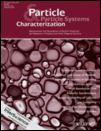
PARTICLE & PARTICLE SYSTEMS CHARACTERIZATION
Innovating Insights in Chemistry and PhysicsPARTICLE & PARTICLE SYSTEMS CHARACTERIZATION is a distinguished journal dedicated to advancing the knowledge within the fields of Chemistry, Condensed Matter Physics, and Materials Science. Published by WILEY-V C H VERLAG GMBH in Germany, this journal has established a solid reputation since its inception in 1984, showcasing research aimed at understanding the intricate properties and behaviors of particulate systems. With an impressive Q2 ranking in its respective categories and Scopus ranks indicating a robust standing in the global research community, it serves as an essential resource for researchers, professionals, and students. Although it does not currently offer Open Access options, its comprehensive articles and reviews provide valuable insights that contribute significantly to the ongoing discourse in these scientific domains. As it prepares to celebrate four decades of publication, PARTICLE & PARTICLE SYSTEMS CHARACTERIZATION continues to provide a vital platform for emerging knowledge, fostering innovation and collaboration among scientists dedicated to the study of particle systems.
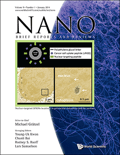
NANO
Innovating Through Nanotechnology ResearchNANO is an esteemed academic journal published by World Scientific Publishing Co. Pte Ltd, focusing on the frontier of nanoscience and nanotechnology. With ISSN 1793-2920 and E-ISSN 1793-7094, this journal has been a pivotal platform for disseminating innovative research from 2008 to 2024. Located in Singapore, NANO has established itself within the academic community, currently holding notable rankings in the Q3 Category for both Condensed Matter Physics and Materials Science, as well as a Q4 Category status in Nanoscience and Nanotechnology. Though it operates under a non-open access model, its contributions are invaluable for researchers, professionals, and students seeking to stay abreast of the latest advancements and interdisciplinary approaches within the nanoscale domain. By providing in-depth articles, reviews, and insights, NANO plays a significant role in advancing our understanding of materials at the nanoscale, thereby fostering innovation and collaboration across related fields.

Nanofabrication
Leading the Charge in Nanotechnology AdvancementsNanofabrication is a leading open-access journal dedicated to advancing the field of nanotechnology through innovative research and comprehensive reviews. Published by the Eurasia Academy Publishing Group (EAPG) since 2014, this journal aims to provide a platform for academic discourse, promoting the latest insights and findings in nanofabrication techniques and applications across diverse domains, including materials science, electronics, and drug delivery systems. With a commitment to accessibility, Nanofabrication ensures that all content is freely available to researchers, professionals, and students worldwide, thereby fostering collaboration and knowledge sharing in the rapidly evolving landscape of nanotechnology. The journal's emphasis on high-quality, peer-reviewed research positions it as an authoritative source for those looking to stay at the forefront of developments in the field.
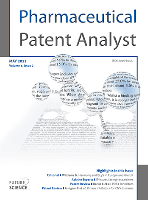
Pharmaceutical Patent Analyst
Illuminating the Path from Discovery to Patent ProtectionPharmaceutical Patent Analyst, published by Taylor & Francis Ltd, is a premier journal dedicated to the evolving fields of pharmaceutical science and patent law. Established in 2012, this journal provides a rigorous platform for scholarly articles, analytical studies, and insightful reviews that delve into the intersection of drug discovery, pharmaceutical innovation, and intellectual property rights. With a Q2 category ranking in Pharmaceutical Science and Q3 rankings in both Drug Discovery and Medicine (miscellaneous), it is recognized for its impactful contributions to the academic community and industry professionals alike. The journal aims to enhance the understanding of patent strategies, explore emerging pharmaceutical technologies, and foster dialogue on regulatory challenges, ultimately facilitating innovation in drug development. Although it does not currently offer open access, its comprehensive and high-quality content remains essential for researchers, professionals, and students pursuing excellence in pharmaceutical research and patent analysis.
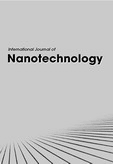
International Journal of Nanotechnology
Pioneering Insights in the World of NanoscienceInternational Journal of Nanotechnology, published by INDERSCIENCE ENTERPRISES LTD, is a prominent academic platform dedicated to advancing research in the rapidly evolving field of nanotechnology. With an ISSN of 1475-7435 and an E-ISSN of 1741-8151, this journal has been contributing valuable insights and innovative findings since its inception in 2004. Although currently not an open-access publication, it serves as an essential resource for researchers, professionals, and students alike, encompassing critical areas such as bioengineering, condensed matter physics, and materials science. The journal is indexed in Scopus, highlighting its academic rigor, albeit ranking in the lower quartiles across several categories. As it progresses towards its 2024 milestone, the International Journal of Nanotechnology continues to play a crucial role in fostering collaborative scientific discourse and pushing the boundaries of knowledge in nanoscience. With a distinguished reputation in the United Kingdom and beyond, it is a vital tool for anyone looking to stay at the forefront of nanotechnology advancements.

FlatChem
Championing Open Access for Groundbreaking Material ScienceFlatChem, an esteemed journal published by ELSEVIER, serves as a premier platform for disseminating high-quality research in the dynamic fields of ceramic and composite materials, electronic and optical materials, materials chemistry, and surfaces, coatings, and films. Since its inception in 2017, the journal has garnered a robust reputation, evidenced by its rank in the top quartile (Q1) across multiple categories, including a commendable rank of #25/127 in Ceramics and Composites and #49/284 in Electronic, Optical and Magnetic Materials. With a focus on pioneering advancements and innovative methodologies, FlatChem not only highlights cutting-edge research but also promotes collaboration and knowledge exchange within the scientific community. The journal’s impact is underscored by its impressive rankings in Scopus, marking it as a vital resource for researchers, professionals, and students aiming to stay at the forefront of materials science. As an open-access journal, it ensures that groundbreaking findings are readily accessible, fostering a broader understanding and application of materials innovation worldwide. The journal is based in the Netherlands, with its headquarters located at RADARWEG 29, 1043 NX AMSTERDAM, NETHERLANDS. Join the vibrant community contributing to FlatChem and engage with the forefront of material advancements.

CRITICAL REVIEWS IN THERAPEUTIC DRUG CARRIER SYSTEMS
Pioneering insights in therapeutic innovations.CRITICAL REVIEWS IN THERAPEUTIC DRUG CARRIER SYSTEMS is an esteemed academic journal published by BEGELL HOUSE INC, focusing on the innovative field of drug delivery systems and therapeutic carriers. With an ISSN of 0743-4863 and E-ISSN 2162-660X, this journal serves as a pivotal resource for researchers, professionals, and students engaged in pharmaceutical sciences and pharmacology. Spanning from 1984 to 2024, it has sustained its relevance in an evolving landscape, holding a commendable Q2 ranking in both Medicine (miscellaneous) and Pharmaceutical Science, as well as a Q3 ranking in Pharmacology for 2023. The journal is well-regarded for its critical and comprehensive reviews that enhance understanding and drive advancements in therapeutic applications. Access options are variable, providing insights into contemporary practices and innovations that shape drug delivery strategies. With a strong emphasis on interdisciplinary approaches, CRITICAL REVIEWS IN THERAPEUTIC DRUG CARRIER SYSTEMS not only fosters scholarly dialogue but also propels forward the critical field of therapeutic delivery, making it a valuable asset for anyone looking to deepen their knowledge and influence within this dynamic area of study.

Advances in Nano Research
Connecting Researchers to the Nano WorldAdvances in Nano Research, published by TECHNO-PRESS, is a prominent academic journal dedicated to advancing knowledge across various facets of nanoscience and nanotechnology. With its ISSN of 2287-237X and E-ISSN 2287-2388, this journal serves as a vital resource for researchers and professionals, focusing on areas such as Atomic and Molecular Physics, Biotechnology, Catalysis, Ceramics and Composites, and Electrical Engineering. Since its inception in 2017, the journal has notably achieved Q2 ranking in multiple categories for the year 2023, reflecting its commitment to high-quality research dissemination and its increasing influence in Scopus rankings, including ranks within the top 12% in Chemical Engineering. While Open Access options are currently unavailable, the rigorous peer-review process ensures that only the most impactful studies are published, further solidifying its importance within the academic community. As a significant player in the fields of engineering and materials science, Advances in Nano Research aims to foster innovation and collaboration, making it an essential publication for those engaged in cutting-edge research and development within the realm of nanotechnology.

JOURNAL OF CLUSTER SCIENCE
Charting New Territories in Biochemistry and BeyondJOURNAL OF CLUSTER SCIENCE, published by SPRINGER/PLENUM PUBLISHERS, is a prominent and influential journal in the fields of Biochemistry, Chemistry, Condensed Matter Physics, and Materials Science. With an ISSN of 1040-7278 and E-ISSN of 1572-8862, this journal has been contributing to scientific discourse since its inception in 1990 and continues to publish cutting-edge research through 2024. It holds a respectable position in the academic landscape with its category quartiles indicating a Q3 ranking in Biochemistry and Q2 rankings in Chemistry, Condensed Matter Physics, and Materials Science as of 2023. The journal's noteworthy Scopus rankings further underscore its relevance, particularly a rank of #82 in Condensed Matter Physics, showcasing its impact and the quality of research disseminated. Although it does not currently offer open access options, it remains a key resource for researchers, professionals, and students who are invested in understanding the complexities of cluster science and its interdisciplinary applications.